British summertime seems to have reverted to the normal state of play because it’s wet and not that warm. Wimbledon was a washout, for the first time in many years. The rowers at Henley Regatta were wet before they entered the somewhat polluted water and staycation holiday makers can be seen dodging the puddles. I’m fed up with it too, but I can at least don a mac and wellies when I’m out there gardening.
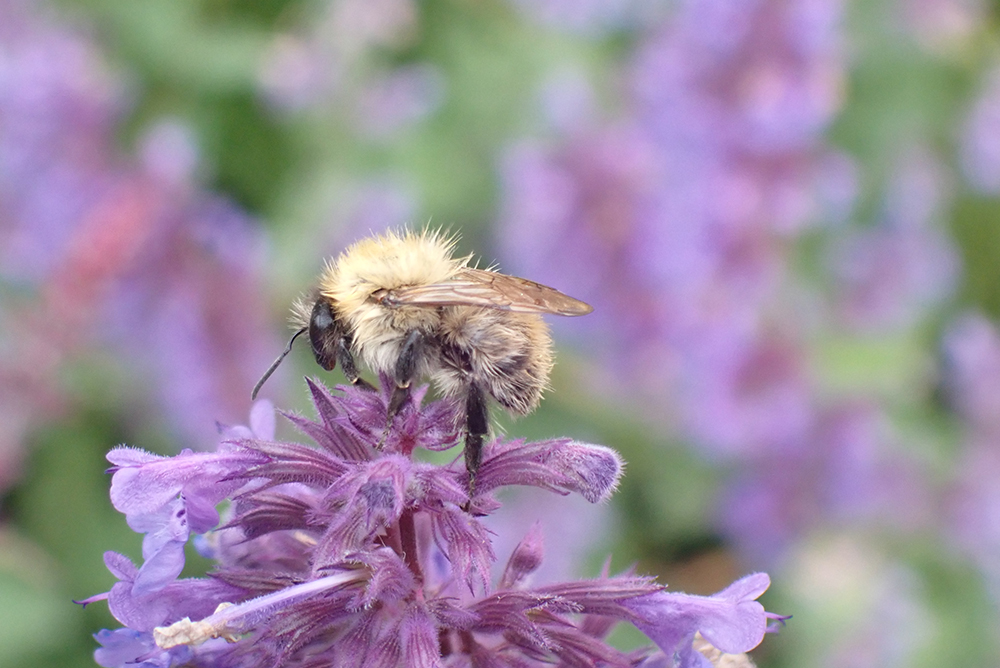
c. Val Bourne
That’s not the case for our solitary and bumblebees, however. These wild bees get cold and wet and they are in very short supply this year, because winter was also wet. Normally, my Nepeta ‘Chettle Blue’ is covered in ginger-backed carder bees, Bombus pascuorum. In lock down year (2020) the sun bleached their hairy bodies to platinum blond and I started to call them Chris Packham bees harking back to my hero’s early television career on The Really Wild Show.
Whenever I pick a plant these days, I try to ensure that it’s going to offer pollen and nectar to my wild bees, because they need a regular supply. They don’t store food in a hive as honey bees do. My newly ordered roses tend to have a boss of stamens in the middle and rose breeders are producing more and more bee-friendly roses and I’m drawn to their simplicity.
I’m very impressed by a German rose breeder named Kordes, because they revolutionised rose breeding some thirty years ago. Many roses that were around then went down with a fungal disease called black spot (Diplocarpon rosae). The leaves develop purple or black spotting and then fall off and this affects the vigour of the rose.
German gardeners had adopted eco-friendly methods by the 1960s and 1970s and they wouldn’t use fungicides in their gardens so German rose sales plummeted. Kordes Roses, which was founded in 1887 at Elshorn near Hamburg by the 22-year-old Wilhelm Kordes, was in financial trouble. They made the made the brave decision to stop spraying their trial fields in order to identify which roses didn’t suffer from black spot. They Kordes company, now run by the 5th generation, sell their roses all over the world. British rose breeders Harkness Roses and David Austin Roses have adopted a similar approach and they are now producing much healthier roses as well.
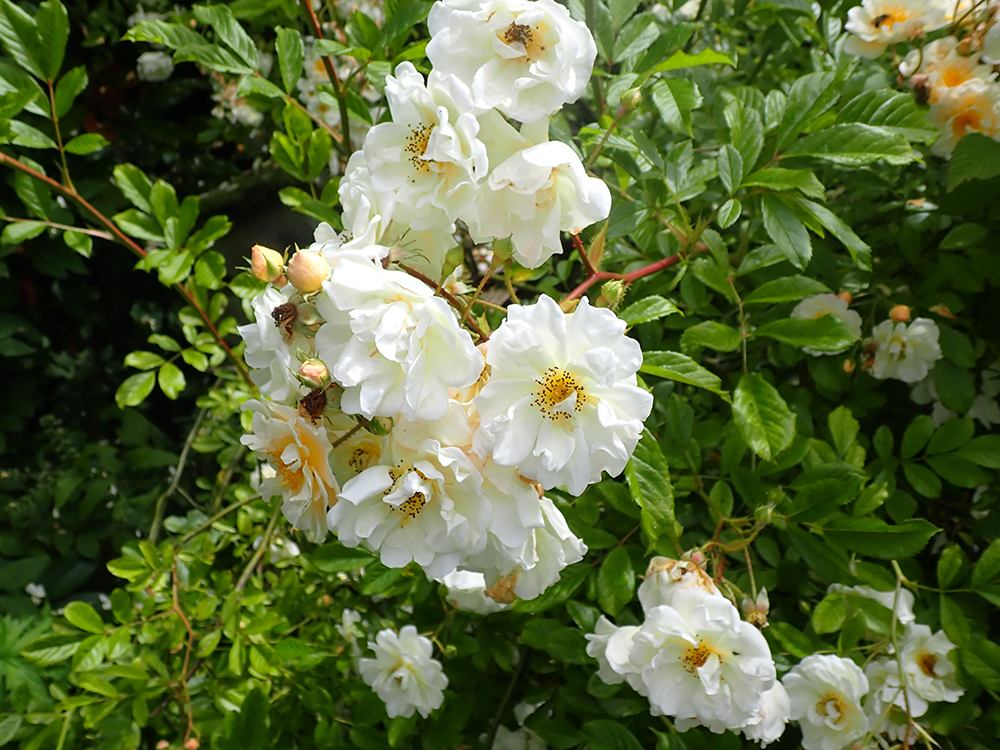
c. Val Bourne
The name in brackets after the sales name, denotes the breeder. Kordes roses always start with KOR. Austin with AUS and Harknes with HAR for instance. ‘Champagne Moment’, for instance, has KORvanaber after its name. This breeding name, or appellation, is important because the commercial name differs according to country. The sales name for ‘Champagne Moment, for instance,’ is the ‘Lion’s Rose’ in the USA.
I grow lots of roses, but they have to be disease-free roses because I’m a life-long organic gardener. I cannot spray with anything. Garlic sprays, soft soap and, even washing-up water, are no-noes for me because they kill a whole range of creatures as well as my aphids. My aphids feed the birds, ladybirds and hoverfly larva so I never fret about them. If one of my roses suffers from blackspot, I will probably have to get rid of it. I may give it a couple of seasons grace, pruning it well, feeding it with high potash Vitax Q4 and picking off or picking up every diseased leaf. If it’s still unhealthy, that rose comes up and a perennial goes into the exact same hole. It’s often a hardy geranium such as ‘Brookside’ or ‘Orion’. The new rose goes in a couple of feet away and this has always worked brilliantly. My roses, by the way, have loved all that rain.
Not all roses suffer from blackspot disease. Rugosas, gallicas, albas and ramblers never get it and that’s due to being close to a wild species. Many of these bombproof roses only flower once in June, but don’t let that put you off. June-flowering roses drip with masses of flowers and they are the ones that turn the garden into your personal rose heaven. Leave the spent heads alone and you’ll often get hips too.
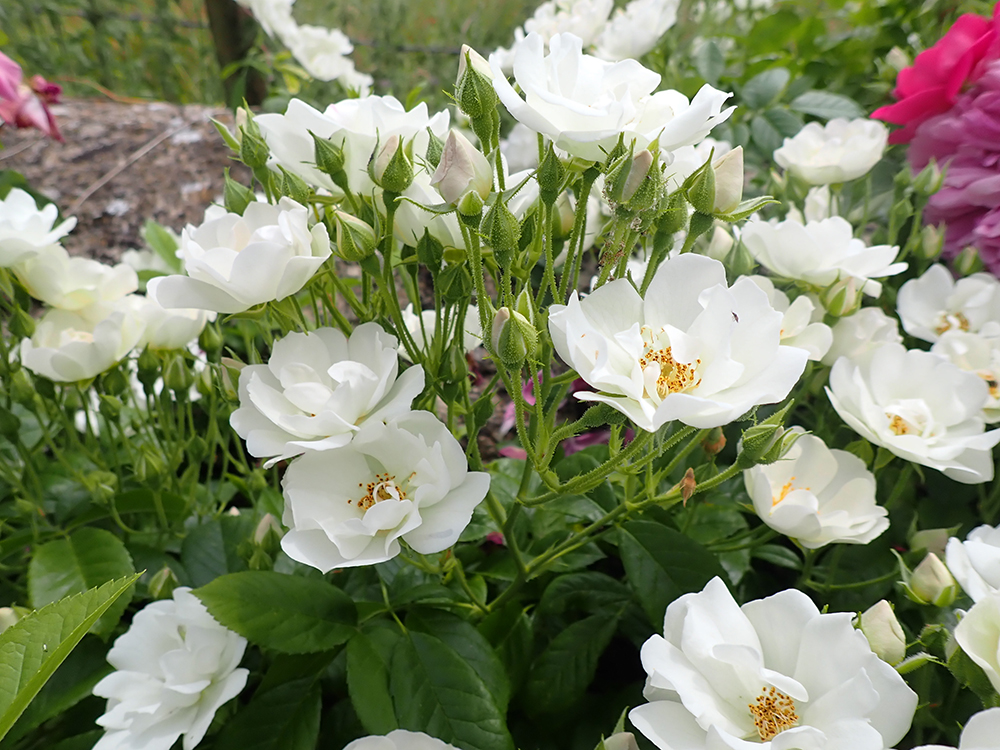
c. Val Bourne
Ramblers vary in size and vigour, so care must be taken when choosing §varieties. I use a modest apricot-flowered rambler named ‘Goldfinch’ on my garden edges. It’s planted with a blue clematis that follows on, named ‘Etoile Violette’. On the low front wall bordering the garden, where there’s more space, I have a lavender-pink that takes up masses of room. It’s named Lauré Davoust’ and she climbs up into a tree. The cream-white ‘Astra Desmond’ is another Spring Cottage favourite. I must have ten June-flowering ramblers on the garden edge and they all flower, producing clusters of small flowers in June.
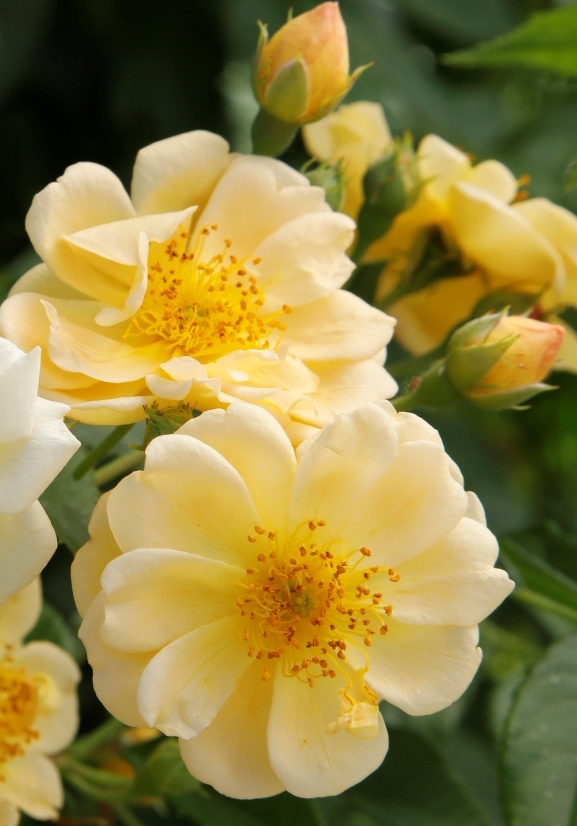
c. Wharton Roses
Repeat-flowering ramblers are a rarity, but Kordes have a SILUETTA series that repeat flowers and only gets up to 2m. These diminutive repeat-flowering roses can be slotted into smaller spaces and grown on fences and walls, or they can be trained onto tripods to add formality and height. There are four available colours SILUETTA® Crimson (KORsilu06), a light pink named SILUETTA® Romantic and SILUETTA® Purple (KORsilu10). I have chosen to grow the pale-yellow named SILUETTA® Sunny (KORsilu05,) because I can see stamens in the middle of the flowers.
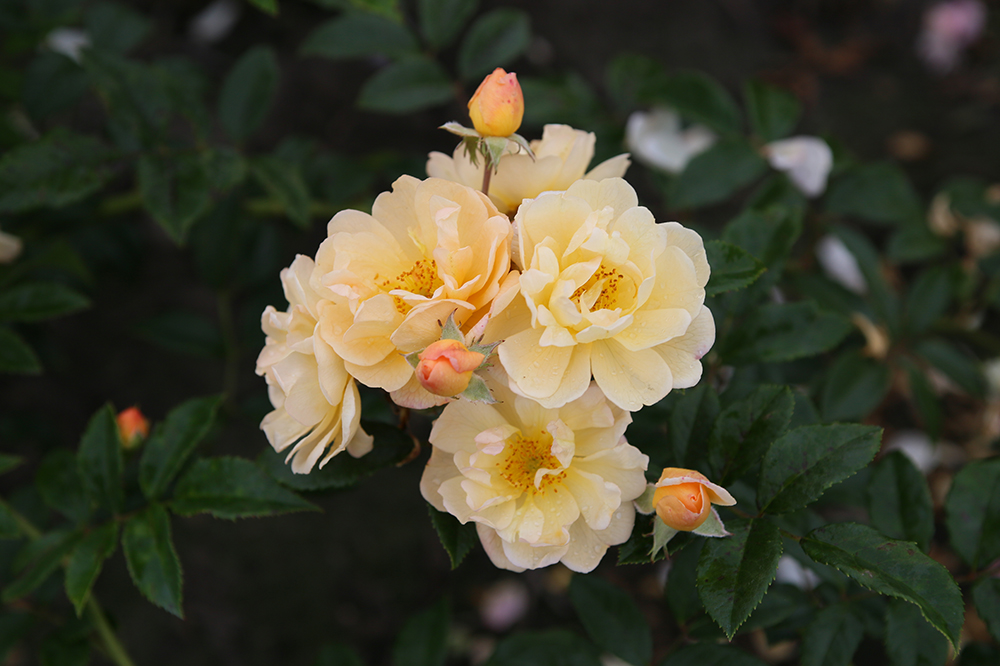
c. Wharton’s Roses
Rambling roses have pliable stems and the optimum time to train them is November, because rose stems tend to get brittle as temperatures drop. The pruning regime varies. If your rambler flowers only once, it will send out new shiny olive-green shoots from the base once it’s established. Count them. If there are three strong shoots this year, remove three of the woodier older stems at the base. Trim the side shoots and tie in the stems, keeping the length. If you do need to reduce them, take off a third. If it’s a repeat-flowering rambler, be gentler. Take out the 3 D’s – the dead, dying and diseased. Take out any crossing branches and tie the new stems in.
The roses in the border are a mixture of double-flowered and single-flowered. I’ve recently planted the ‘Tottering-By-Gently Rose raised by David Austin and named in 2018 to celebrate the 25th anniversary of Annie Tempest’s popular cartoon at the back of Country Life. This shrub rose should reach four-feet in height (120cm) and it will bear clusters of lucid-yellow flowers. I’ve positioned it behind a stand of a spectacular blue sea holly, Eryngium x zabelii ‘Big Blue’, because blue and yellow work really well together.
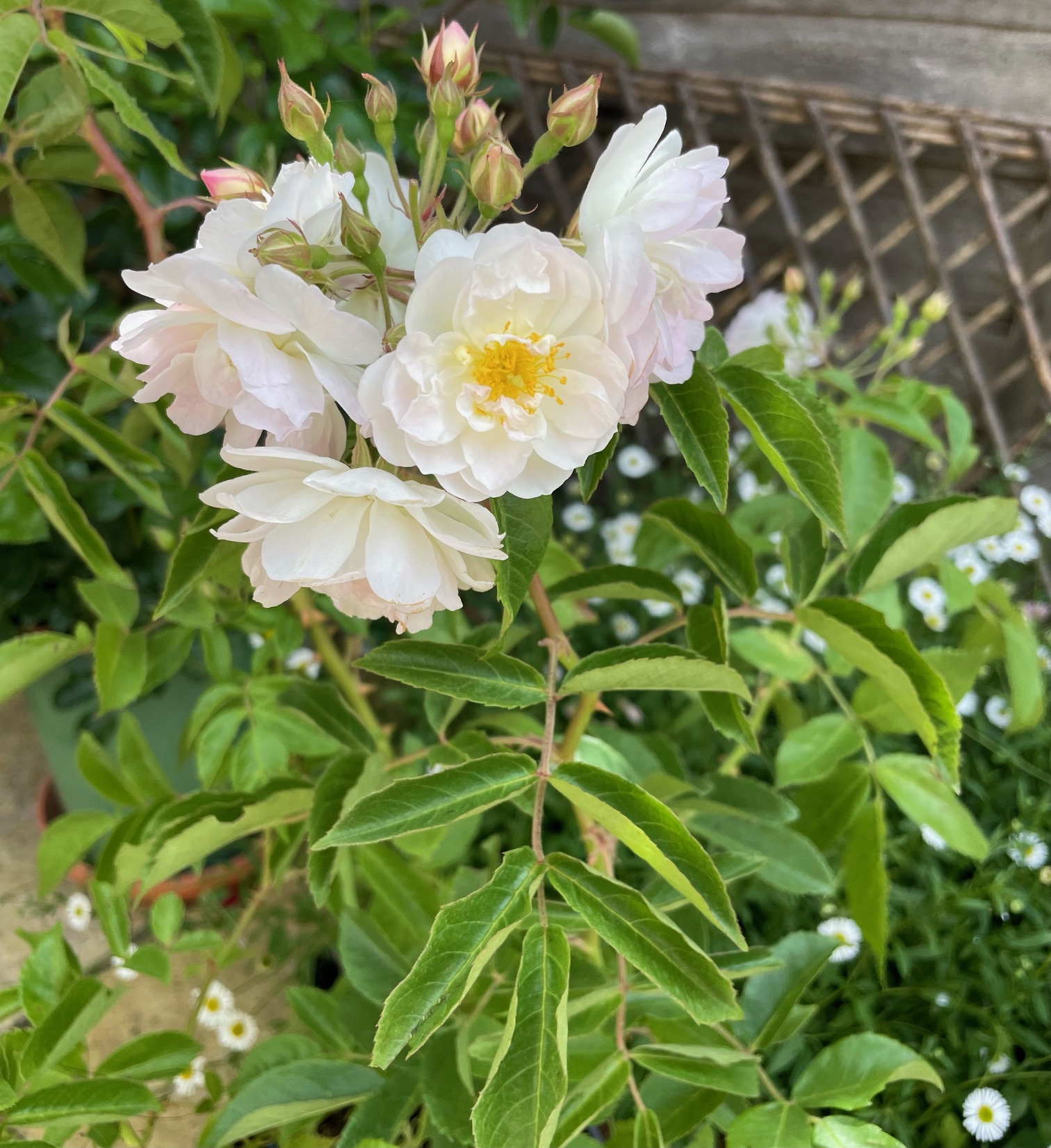
c. Marilyn Stevens Roses UK
‘Sally Holmes’ is another personal favourite, with clusters of large pale flowers that develop shades of pink and apricot. The foliage is equally handsome, but it’s the pearlescent flowers I love. ‘Pearl Drift has the same sort of luminescence and it always has a glorious September flush. I’m also growing Harkness’s ‘Sense and Sensibility’ for its fresh green foliage and succession of pretty pale-pink semi-double flowers. Every sale supports the Jane Austen’s House. Charity No 1156458.
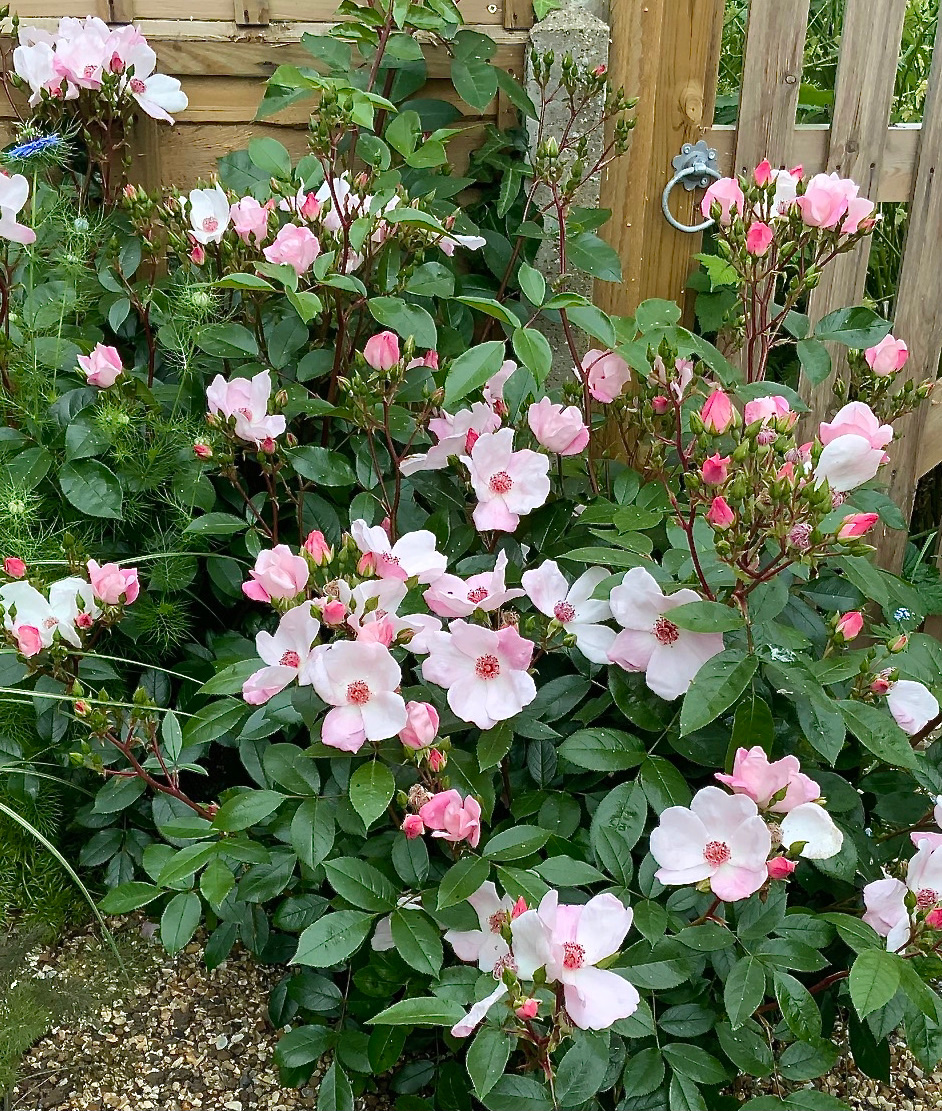
c. Marilyn Stevens Roses UK
Some of the French-bred roses are good on poorer ground and Meilland’s ‘Bonica’ is threaded through a border leading to the front door. This 1982 rose bears large trusses of semi-double pink flowers, sometimes up to twenty or more per stem. It begins here in July, later than most, and carries on very late as well. I’ve just planted Meilland’s ‘Sweet Pretty’, released in 2015, having fallen in love with the pale pink flowers studded in orange stamens and there’s a hint of purple too.
I’ve been growing ‘For Your Eyes Only’ in my border, close to ‘Bonica’, but I’ve discovered that this is a Marmite rose. Some people (like me) love it, for its wavy-edged pale salmon-pink flowers middled in maroon. Others hate it. Lots of roses with R. persica in their bloodline have this darker middle. ‘For Your Eyes Only’ was Rose of the Year 2015. It’s widely sold though, just like Marmite, and hardly ever out of flower. And those flowers are hardly every without a grateful bee – when the weather’s fine!
Next Year’s 2025 Rose of the Year is ‘You’re My Everything’ and this hybrid-tea pink-blend rose has stamens in the middle, once the spiral buds open. Yippee!











